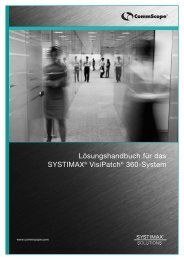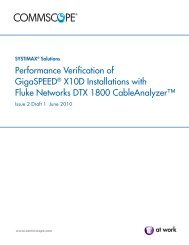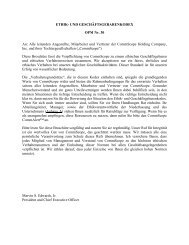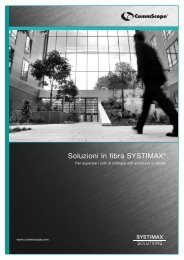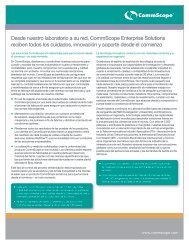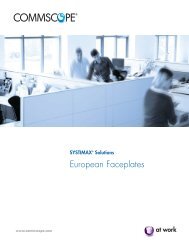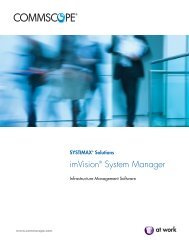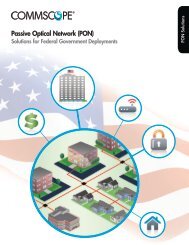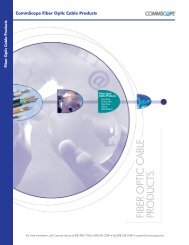CommScope® Enterprise Data Center Design Guide - Public ...
CommScope® Enterprise Data Center Design Guide - Public ...
CommScope® Enterprise Data Center Design Guide - Public ...
You also want an ePaper? Increase the reach of your titles
YUMPU automatically turns print PDFs into web optimized ePapers that Google loves.
12<br />
Bus<br />
Ring (also called Token Ring)<br />
Star<br />
Point-to-point<br />
www.commscope.com<br />
Ring Topologies<br />
In a physical ring topology, the nodes of a network are all connected in a closed loop. Instead<br />
of running back and forth between nodes, the signal travels in one direction around the ring. In<br />
some networks, active and stand-by parallel circuits operate in both directions simultaneously (a<br />
counter-rotating ring). Rings are normally used in the campus backbone segment of a network.<br />
Their advantage is that if a cable is cut or a node fails, the network will continue to operate.<br />
However, adding more nodes to the ring is difficult. Trying to adapt bus or star logical<br />
topologies to a ring may result in unacceptable connection loss.<br />
Mesh Topologies<br />
In a physical mesh topology, every device or node is connected to every other device or node<br />
in the network. Adding a device or node requires multiple connections.<br />
Network Logical Topologies<br />
Bus<br />
Defined under IEEE 802.3, this is a popular protocol in which signals travel in both directions on<br />
a common path. In most 802.3 systems, collision detection software in the active equipment<br />
directs the traffic so that network subsystems do not try to send and receive at the same time.<br />
Common bus protocols include the Ethernet family and MAP (Manufacturing Automation Protocol).<br />
Ring (also called Token Ring)<br />
Defined under IEEE 802.5, signals travel in one direction on one path and the opposite<br />
direction on another (a counter-rotating ring). A ring’s advantage is reliability - if the connection<br />
should be cut or a node fails to function, the ring bypasses the failed component and continues<br />
to operate. Another version of a ring is FDDI (Fiber Distributed <strong>Data</strong> Interface defined under<br />
ANSI X3T9) written specifically for optical fiber.<br />
Star<br />
In a star, all of the components connect into a central node that distributes the traffic back out.<br />
Most private telephone networks are star topologies. Terminal/mainframe computer<br />
connections are normally star topologies as well.<br />
Mesh Topology<br />
Devices are connected to every other device in the network. In a true mesh topology every<br />
device has a connection to every other device in the network.<br />
Point-to-Point<br />
This is the simplest type of connection, linking a minimum of two devices over a transmit/<br />
receive link. CCTV, Fibre Channel, ESCON and VSAT (and other satellite antenna links) are<br />
point-to-point topologies.



